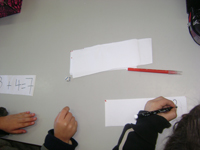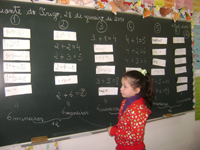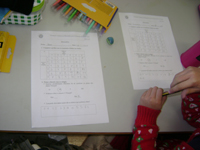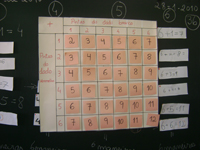

 |
How many dots? |
 |
Portel - Portugal |
||||
| Age: 6 Aims: • To make regressive and progressive counts on; • To compose and decompose numbers; • To compare and order numbers; • To memorize basic facts of addiction; • To use mental and written calculation strategies for the necessary operations; • To verify the existence of doubles; • To formulate and test conjectures related with simple mathematics situations; • To communicate orally and in writing , using the natural language and mathematical language, interpreting, expressing and discussing results, processes and mathematical ideas; Materials: Presentation (pupils): Strips of paper with the register of the dots achieved from the several launches made by both teams. Introduction: • Oral explanation of the work to be done in the classroom - 10 minutes; • Five groups composed by four pupils each; Clarification of some main concepts/ main questions to be made : • What do you know about dice? • Launch the dices and write the number of dots. • Add the number of dots of both sides. What's the result? Write it down on the sheet. • When throwing the two dice at the same time, how many opportunities of get out the same number of different spots are there? • Did you already find out all possible different combinations? Compare your work with your colleague or submit it to the class. • Find out many other possibilities that you didn't find out or register. • Exploration of the task carried out by the pupils – 20 min. – group work • Discussion of the task – 40 min – large group/class • Final systemization – 10 min. – large group/classMain part: - Pupils should solve the task autonomously but under the supervision of the teacher - Presentation: Slips of paper with the registration of the dots achieved from the launch of both teams - Discussion of the results in large group - Contents systematization Roundup:
- They can easily find out that: .the addition of the dots from one side with the dots of the dice doesn't change if we modify the order of the parcels. Ex. 4+3=7 e 3+4=7; . by launching two dices there are 36 different possibilities of matching the dots and obtain numbers comprehended between 2 and 12 include; . we can never obtain o nº1 because none of the dices has a face without dots; . by launching two dices its possible to obtain six different doubles (1+1, 2+2, 3+3, 4+4, 5+5 e 6+6); .each number of dots from one side its possible to combine with six different numbers from the other side of the dice (6x6=36 possibilities).
|
||||
 |
 |
|||
 |
 |
|||
 |
|
|||